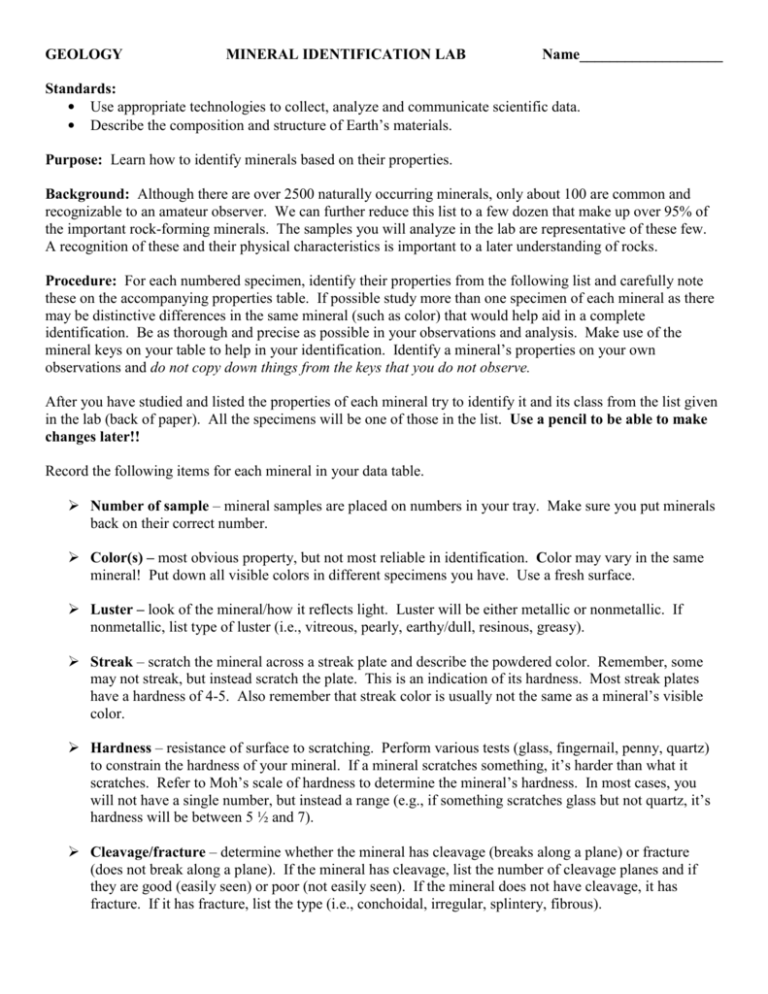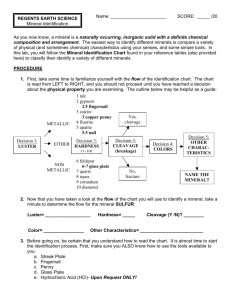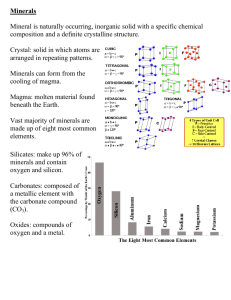File
advertisement

GEOLOGY MINERAL IDENTIFICATION LAB Name___________________ Standards: • Use appropriate technologies to collect, analyze and communicate scientific data. • Describe the composition and structure of Earth’s materials. Purpose: Learn how to identify minerals based on their properties. Background: Although there are over 2500 naturally occurring minerals, only about 100 are common and recognizable to an amateur observer. We can further reduce this list to a few dozen that make up over 95% of the important rock-forming minerals. The samples you will analyze in the lab are representative of these few. A recognition of these and their physical characteristics is important to a later understanding of rocks. Procedure: For each numbered specimen, identify their properties from the following list and carefully note these on the accompanying properties table. If possible study more than one specimen of each mineral as there may be distinctive differences in the same mineral (such as color) that would help aid in a complete identification. Be as thorough and precise as possible in your observations and analysis. Make use of the mineral keys on your table to help in your identification. Identify a mineral’s properties on your own observations and do not copy down things from the keys that you do not observe. After you have studied and listed the properties of each mineral try to identify it and its class from the list given in the lab (back of paper). All the specimens will be one of those in the list. Use a pencil to be able to make changes later!! Record the following items for each mineral in your data table. Number of sample – mineral samples are placed on numbers in your tray. Make sure you put minerals back on their correct number. Color(s) – most obvious property, but not most reliable in identification. Color may vary in the same mineral! Put down all visible colors in different specimens you have. Use a fresh surface. Luster – look of the mineral/how it reflects light. Luster will be either metallic or nonmetallic. If nonmetallic, list type of luster (i.e., vitreous, pearly, earthy/dull, resinous, greasy). Streak – scratch the mineral across a streak plate and describe the powdered color. Remember, some may not streak, but instead scratch the plate. This is an indication of its hardness. Most streak plates have a hardness of 4-5. Also remember that streak color is usually not the same as a mineral’s visible color. Hardness – resistance of surface to scratching. Perform various tests (glass, fingernail, penny, quartz) to constrain the hardness of your mineral. If a mineral scratches something, it’s harder than what it scratches. Refer to Moh’s scale of hardness to determine the mineral’s hardness. In most cases, you will not have a single number, but instead a range (e.g., if something scratches glass but not quartz, it’s hardness will be between 5 ½ and 7). Cleavage/fracture – determine whether the mineral has cleavage (breaks along a plane) or fracture (does not break along a plane). If the mineral has cleavage, list the number of cleavage planes and if they are good (easily seen) or poor (not easily seen). If the mineral does not have cleavage, it has fracture. If it has fracture, list the type (i.e., conchoidal, irregular, splintery, fibrous). Other properties – anything else about your mineral that does not fit into the categories above. Examples: magnetic, smell, striations (lines on surface), feel, acid reactivity (effervesces/bubbles with acid, anything else (make good observations). Mineral Classes and Names: minerals are listed under their class. Silicates Quartz Feldspars – microcline orthoclase perthite olivine topaz muscovite (clear mica) biotite (black mica) lepidolite (lavender mica) hornblende talc tourmaline pyroxine Sulfates gypsum Sulfides galena pyrite Carbonates calcite Elements graphite sulfur copper Oxides hematite magnetite corundum Halides (salts) halite fluorite Questions 1. Which properties were most useful in identifying minerals? 2. Which minerals have high density (feel heavy for their size) and are metallic? Name at least two. 3. Which minerals were easiest to identify? Hardest? 4. What mineral in the lab was the hardest (from Moh’s scale)? The softest? 5. Name a mineral in the lab with 1 direction of cleavage. Name one with 2 directions of cleavage. Name one with 3 directions of cleavage. Conclusion Use the RACE method to answer the following question: “How are the physical properties used to identify minerals?” (Hint: “how” does not mean to list the properties, it means to DESCRIBE how they are used).






